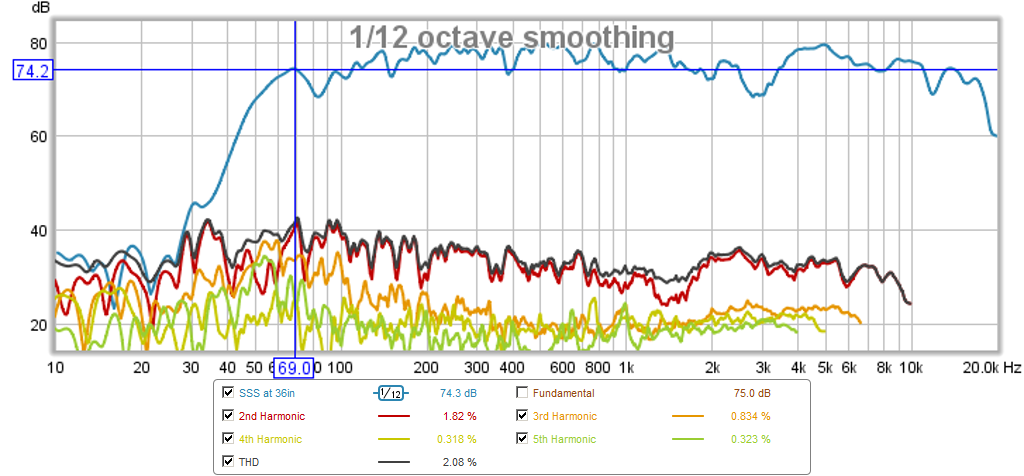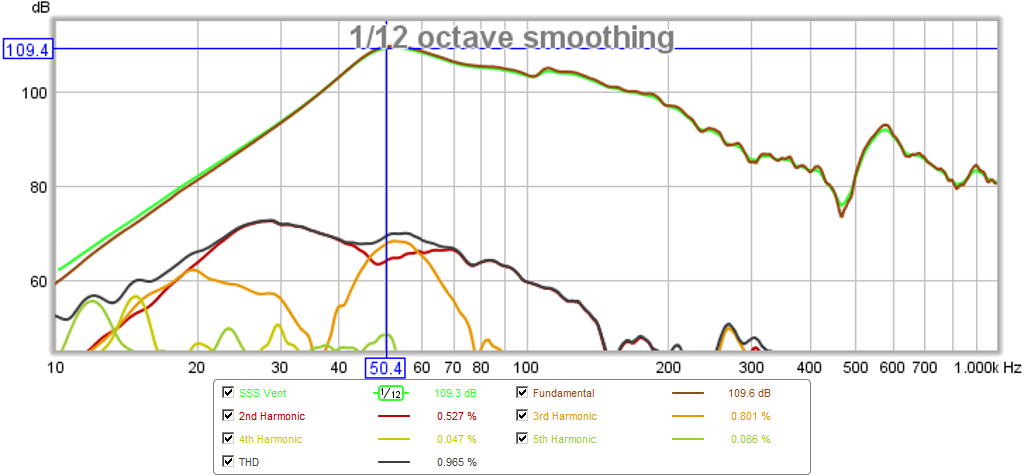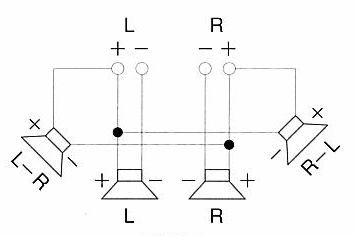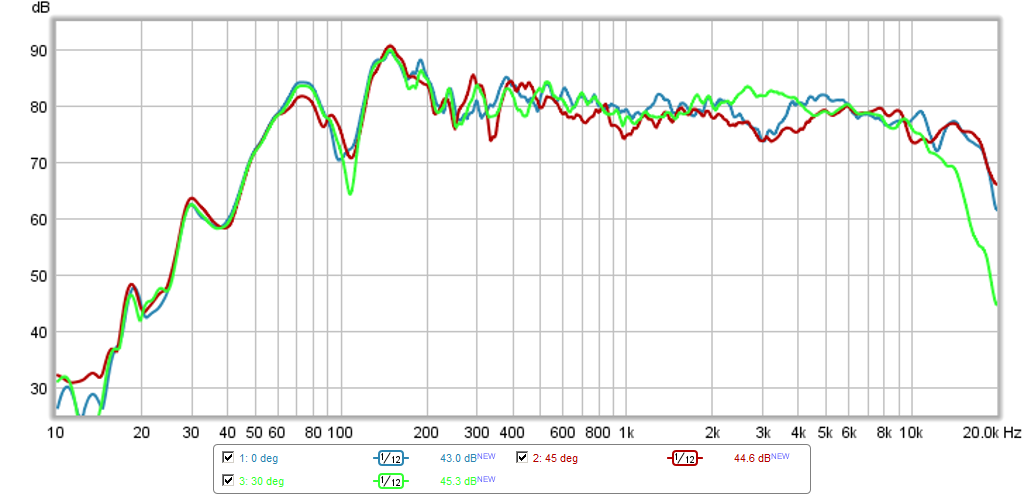DeonC,
Those appear to be closed back drivers? They don't even need a box - just hot melt glue them on top of a an existing woofer cabinet. Run your woofer with low pass at 200 Hz and the four drivers on top in a matrix high passed at 200 Hz. 😕 It might look something like that speaker above from the 70's. If you want to use your 4 in car speakers run those in a box tuned appropriately for below 200 Hz.
Main thing is to experiment with quick and dirty concepts first before making anything in wood.
OT: how is the MOAK build coming along?
Those appear to be closed back drivers? They don't even need a box - just hot melt glue them on top of a an existing woofer cabinet. Run your woofer with low pass at 200 Hz and the four drivers on top in a matrix high passed at 200 Hz. 😕 It might look something like that speaker above from the 70's. If you want to use your 4 in car speakers run those in a box tuned appropriately for below 200 Hz.
Main thing is to experiment with quick and dirty concepts first before making anything in wood.
OT: how is the MOAK build coming along?
Here is the same three options with the woofers added on the bottom:
An externally hosted image should be here but it was not working when we last tested it.
An externally hosted image should be here but it was not working when we last tested it.
An externally hosted image should be here but it was not working when we last tested it.
Those appear to be closed back drivers?
Unfortunately they aren't. The baskets are open at the back, just like the following driver:
An externally hosted image should be here but it was not working when we last tested it.
I actually think it is better that way. A closed back driver can sound a bit shut-in.
OT: how is the MOAK build coming along?
It has been vetoed by my landlord. 🙁 I will be too big, so I am not allowed to build it. As soon as I have a place of my own... [special=MOAK time!!!]%[/special] 😀
Deon
I might have missed it but... If I have a driver that needs an 4 liter box and I'm going for the 4 driver system, do I build this box 16 liters?
If the a single driver design calls for a 4 liter box with a port that is 1 inch by 3 inches, how do I arrange my port/ports?
Sorry if this was covered...
Mike
If the a single driver design calls for a 4 liter box with a port that is 1 inch by 3 inches, how do I arrange my port/ports?
Sorry if this was covered...
Mike
Mikej,
That is why I said 3-5 liters and yes you would need 3x4 or 12 liters for 4 drivers if they were all driven in phase. But I think with matrix wiring this may not be true. For sealed case there is flexibility if you want to keep it small go 12 liters same as what I made. Can work with 4 drivers too. If you want bass reflex use same vent I have. To calculate vents yourself use a program like WinISD and put 4 drivers and 12 liters or whatever you end up choosing. Set your freq to tune box and it calculates vent dimensions. WinISD will pick some huge box by default since the Qts is so high - it defaults to 15 liters and 55 Hz for a single driver IIRC. 60 liters or 2 cu ft is too big for these drivers and is an eyesore that big. Tune higher like 70 or 80 Hz and use smaller volume. That is just my recommendation for tc9fd. If you use another driver like a Tang Band W4 with a Wts of about 0.45 it will be a smaller box.
That is why I said 3-5 liters and yes you would need 3x4 or 12 liters for 4 drivers if they were all driven in phase. But I think with matrix wiring this may not be true. For sealed case there is flexibility if you want to keep it small go 12 liters same as what I made. Can work with 4 drivers too. If you want bass reflex use same vent I have. To calculate vents yourself use a program like WinISD and put 4 drivers and 12 liters or whatever you end up choosing. Set your freq to tune box and it calculates vent dimensions. WinISD will pick some huge box by default since the Qts is so high - it defaults to 15 liters and 55 Hz for a single driver IIRC. 60 liters or 2 cu ft is too big for these drivers and is an eyesore that big. Tune higher like 70 or 80 Hz and use smaller volume. That is just my recommendation for tc9fd. If you use another driver like a Tang Band W4 with a Wts of about 0.45 it will be a smaller box.
Here is the same three options with the woofers added on the bottom:
An externally hosted image should be here but it was not working when we last tested it.
An externally hosted image should be here but it was not working when we last tested it.
An externally hosted image should be here but it was not working when we last tested it.
I like first option as the comb filtering will be minimal in left right with that one. Sorry about the MOAK. 🙁
Here is the driver (and factory T/S parameters) I'll use if I build this project:
Tang Band W3-879S 3" Shielded Driver
Specifications: Power Handling: 15 watts RMS/30 watts max * Voice coil diameter: 3/4" * Nominal Impedance: 8 ohms * Re: 6.6 ohms * Frequency range: 105-20,000 Hz * Fs: 105 Hz * SPL: 86 dB 1W/1m * Vas: .06 cu.ft. * Qms: 7.22 * Qes: .65 * Qts: .59 * Xmax .5 mm * Dimensions: Overall Diameter: 3-5/8", Cutout Diameter: 3", Mounting Depth: 2", Magnet Diameter: 2-5/8"
I built a bass reflex for this and it was approximately 4 liters with a 1" X 2.7" port. I never measured it, but I did like the sound of it. I still have six of these drivers, so I might try them in this build. I can go with a sub if need be.
So a box that is 12-16 liters with a vent yet to be configured on WinISD (or Jeff Bagby's software?) should work?
I'm all ears and open to suggestions.
Thanks,
Mike
Tang Band W3-879S 3" Shielded Driver
Specifications: Power Handling: 15 watts RMS/30 watts max * Voice coil diameter: 3/4" * Nominal Impedance: 8 ohms * Re: 6.6 ohms * Frequency range: 105-20,000 Hz * Fs: 105 Hz * SPL: 86 dB 1W/1m * Vas: .06 cu.ft. * Qms: 7.22 * Qes: .65 * Qts: .59 * Xmax .5 mm * Dimensions: Overall Diameter: 3-5/8", Cutout Diameter: 3", Mounting Depth: 2", Magnet Diameter: 2-5/8"
I built a bass reflex for this and it was approximately 4 liters with a 1" X 2.7" port. I never measured it, but I did like the sound of it. I still have six of these drivers, so I might try them in this build. I can go with a sub if need be.
So a box that is 12-16 liters with a vent yet to be configured on WinISD (or Jeff Bagby's software?) should work?
I'm all ears and open to suggestions.
Thanks,
Mike
Oh great, yet another fascinating timewaster for me 🙂 Long ago, maybe 1984, my first true speaker was a knock-off (using cheap fullrangers) of the Polk SDA-1. It worked ok. Later I had bought four Radio Shack Minimus-7 speakers (these were great $50 each, are they still made?) and found you could set these up in a SDA like array (the key being that the distance between pairs of speakers was about 6 1/2 inches (center to center) matching the inter-ear distance.)
I guess this is similar to the M-S method shown in this thread. Rather than make a new enclosure, I like the idea given to try it with Bose 901s. I fit the bill perfectly. I now own four pair of 901s, various amps and EQs. Seems would be pretty easy to set up a test bed with three or four 901s each fed by a signal from a MiniDSP 2x4 through a Behringer NU4-6000. Only issue is how to matrix it. Seems one obstacle might be the too-large (?) size of each 901 enclosure; could this perhaps be adjusted with time delay on each channel?
I guess this is similar to the M-S method shown in this thread. Rather than make a new enclosure, I like the idea given to try it with Bose 901s. I fit the bill perfectly. I now own four pair of 901s, various amps and EQs. Seems would be pretty easy to set up a test bed with three or four 901s each fed by a signal from a MiniDSP 2x4 through a Behringer NU4-6000. Only issue is how to matrix it. Seems one obstacle might be the too-large (?) size of each 901 enclosure; could this perhaps be adjusted with time delay on each channel?
Besides the diffused source like Bose 901, I'm also waiting for someone trying 3 x 30 degree waveguide, against the wall...
Here is the driver (and factory T/S parameters) I'll use if I build this project:
Tang Band W3-879S 3" Shielded Driver
Specifications: Power Handling: 15 watts RMS/30 watts max * Voice coil diameter: 3/4" * Nominal Impedance: 8 ohms * Re: 6.6 ohms * Frequency range: 105-20,000 Hz * Fs: 105 Hz * SPL: 86 dB 1W/1m * Vas: .06 cu.ft. * Qms: 7.22 * Qes: .65 * Qts: .59 * Xmax .5 mm * Dimensions: Overall Diameter: 3-5/8", Cutout Diameter: 3", Mounting Depth: 2", Magnet Diameter: 2-5/8"
I built a bass reflex for this and it was approximately 4 liters with a 1" X 2.7" port. I never measured it, but I did like the sound of it. I still have six of these drivers, so I might try them in this build. I can go with a sub if need be.
So a box that is 12-16 liters with a vent yet to be configured on WinISD (or Jeff Bagby's software?) should work?
I'm all ears and open to suggestions.
Thanks,
Mike
If you liked the sound of the above 4L box with 1"x2.7" port, to first order approximation just multiply by 4x. That is make volume 16L and use qnty 4 x 1" x 2.7" long ports. That is four separate ports - if you want to combine into one bigger port you need to use the software as it accounts for pressure losses in port due to wall circumference.
Update on Foam Core SSS with TC9FD's
I tested the SSS far away from a wall to see if the phantom stereo image could improve - and it did. I also measured the frequency response away from a wall and it still has sufficient bass to not require a BSC circuit. The speaker is 48 in from a back wall and the drivers are 36 in above the floor. Here is the frequency response and harmonic distortion at a typical listening level in the mid 70's dB SPL. I am also including a sound clip to demonstrate what it sounds like away from the wall.

The dip near 3kHz is predicted in the sim - it is a cancellation as a result of left-right driver-driver comb interference and goes away as you move off axis.
Here is the response of the vent (measured at exit plane):

That is a pretty low 50 Hz peak in the output and distortion is relatively low (1%) at this moderate SPL level.
I tested the SSS far away from a wall to see if the phantom stereo image could improve - and it did. I also measured the frequency response away from a wall and it still has sufficient bass to not require a BSC circuit. The speaker is 48 in from a back wall and the drivers are 36 in above the floor. Here is the frequency response and harmonic distortion at a typical listening level in the mid 70's dB SPL. I am also including a sound clip to demonstrate what it sounds like away from the wall.

The dip near 3kHz is predicted in the sim - it is a cancellation as a result of left-right driver-driver comb interference and goes away as you move off axis.
Here is the response of the vent (measured at exit plane):

That is a pretty low 50 Hz peak in the output and distortion is relatively low (1%) at this moderate SPL level.
Attachments
Last edited:
Hi!
In a MX-1 style (4 drivers) version: how and where to connect the bass drivers for extra bass output?
Should be only one driver or two?
Should be paralell connected with the 2 fron drivers?
Anyway how much impedance see the amplifier from such a speakers????
Greets:
Tyimo
I think best to connect two bass drivers directly to R and L inputs. Propably with low pass filter coil, if bass drivers don't behave nicely at higher frequencies. Impedance will be a bit lower than normal.
Here again Nagaoka four element matrix (MX-1)

.
Mic at 1 meter away, speaker 2 in from back wall at 50 in above ground sitting on top of amplifier deck (which may be causing bounce dip).
0 deg, 30 deg, 45 deg. The response in the mid to high freq is pretty flat and bass reaches 70 Hz as predicted. The +10 dB peak at 150 hz may be a problem though - not sure what it is caused by. Also, no BSC needed as predicted.

A decent sounding speaker actually.
I suppose these responses are for mono signal L=1 and R=1 ?
How does it look like with hard side panned signal e.g. L=1 and R=0 ? Now there should be a clearly directed sound to the panned side.
.
I keep being intrigued by the concept discussed here, but know I don't have a proper space to set this up on anything but a temporary basis, at least for now.
Using fullrange drivers is an obvious, easy and simple solution. I was thinking the small ApexJr Vifa 4" coaxial might be fun too. The main difference would be in the much wider beamwidth in the treble region, since a 0.75" tweeter is on there. Would this be an issue with regard to the proper working of a 45° matrix speaker? Maybe Elias' initial 90° scheme would be a better choice for these?
Scroll down roughly halfway:
Speaker Stuff
I think there is a minimum size of a driver which works best. A dome tweeter placed on the side of the box will leak quite a lot of sound directly to the listening position despite the matrix tells it to send the signal towards the side wall. So it does not do the proper job it should.
One could try placing some acoustic absorber beside the side tweeters to attenuate the leaked waves.
.
I think there is a minimum size of a driver which works best. A dome tweeter placed on the side of the box will leak quite a lot of sound directly to the listening position despite the matrix tells it to send the signal towards the side wall. So it does not do the proper job it should.
One could try placing some acoustic absorber beside the side tweeters to attenuate the leaked waves.
.
It's what I was afraid of. A 0.75" tweeter should in theory have output up to ~10kHz 180° off-axis.
Oh great, yet another fascinating timewaster for me 🙂 Long ago, maybe 1984, my first true speaker was a knock-off (using cheap fullrangers) of the Polk SDA-1. It worked ok. Later I had bought four Radio Shack Minimus-7 speakers (these were great $50 each, are they still made?) and found you could set these up in a SDA like array (the key being that the distance between pairs of speakers was about 6 1/2 inches (center to center) matching the inter-ear distance.)
I guess this is similar to the M-S method shown in this thread. Rather than make a new enclosure, I like the idea given to try it with Bose 901s. I fit the bill perfectly. I now own four pair of 901s, various amps and EQs. Seems would be pretty easy to set up a test bed with three or four 901s each fed by a signal from a MiniDSP 2x4 through a Behringer NU4-6000. Only issue is how to matrix it. Seems one obstacle might be the too-large (?) size of each 901 enclosure; could this perhaps be adjusted with time delay on each channel?
It is my understanding that Polk was rather based on an attempt of interaural cross talk cancellation than MS-stereo ?
.
Here is the same three options with the woofers added on the bottom:
An externally hosted image should be here but it was not working when we last tested it.
An externally hosted image should be here but it was not working when we last tested it.
An externally hosted image should be here but it was not working when we last tested it.
Looks like any of them will do. If you make 45 degree angled side walls, could even try orienting side drivers laterally.
The bass will be monoish anyway due to small driver spacing and due to not using a bass matrix.
However, it gives a good taste of what to expect when stereo is served from another perspective.
I hope those oval drivers are good enough, though...
.
I suppose these responses are for mono signal L=1 and R=1 ?
How does it look like with hard side panned signal e.g. L=1 and R=0 ? Now there should be a clearly directed sound to the panned side.
.
Yes, the measurement is with the same signal through both left and right. I did a hard pan by disconnecting one of the channels and you can definitely hear the sound go to the left or right even though one side and the center channel continued to work. What was surprising was what it sounds like when listening to a single left or right and the center then reconnecting the other side during music play. The stereo effect is definitely there.
Yes, the measurement is with the same signal through both left and right. I did a hard pan by disconnecting one of the channels and you can definitely hear the sound go to the left or right even though one side and the center channel continued to work. What was surprising was what it sounds like when listening to a single left or right and the center then reconnecting the other side during music play. The stereo effect is definitely there.


 I assume you did not disconnect the amplifier from the matrix while panning ? One cannot pan matrix speaker by disconnecting an amplifier. Both left and right amplifiers must remain connected. It's all about impedances. An amplifier provides zero ohm drive for the matrix even without a signal on a particular channel.
I assume you did not disconnect the amplifier from the matrix while panning ? One cannot pan matrix speaker by disconnecting an amplifier. Both left and right amplifiers must remain connected. It's all about impedances. An amplifier provides zero ohm drive for the matrix even without a signal on a particular channel..
I tested the SSS far away from a wall to see if the phantom stereo image could improve - and it did.
This is interesting observation and in some ways similar to my experience.
What I used to observe is that delayed front wall reflections improve stereo performance. This is not only for single speaker stereos, but true also in general.
In case of single speaker stereo, missing or attenuated front wall reflections can lead to a narrow imaging. I think this is due to second order front wall reflection (front wall -> side wall -> listener) actually increases the lateral energy. In a small room imaging can be improved by increasing the overal energy coming from a particular direction. In a way reflections form a cluster of sound which is perceived as an entity.
This is not just the plain old 'law of the first wavefront' which has only limited use in a small room with multiple of early reflections. This was discussed in length in another thread sometime in the past.
.
- Home
- Loudspeakers
- Full Range
- Master Nagaoka Tetsuo explorations on matrixed single stereo speakers

